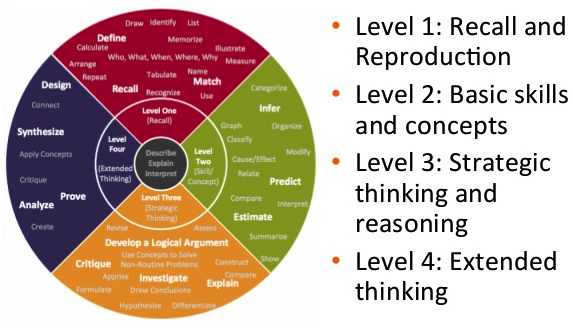
When the right level of rigor is applied, students are engaged with their learning and will think in ways that can help them be successful in the future. Level 4 thinking is an essential 21st century skill, so all students must be exposed to this level of thinking and supported as needed. This could be accomplished through projects or even short activities, such as writing on quick tasls or developing conjectures with a peer. Level 4 activities ask students to consider their knowledge and skills and generate something that is their very own. Level 4 is when students are creating their own thinking. A student both designing and conducting an experiment is a demonstration of this level. This level requires complex reasoning, planning, developing, and thinking, most likely over a period of time.


The last level of the of the four is the most complex. All learners can engage in level 3 activities, although some may need more support than others. When students are able to execute level 3 thinking, they may have mastered the concepts. Level 3 asks students to use skills and knowledge in new combinations outside of the original context. This level is more complex and abstract than the previous two. Asking students to explain their thinking is a part of this level. This level requires reasoning, planning, using evidence, and a higher level of thinking. Having students work together is a great way to provide support and deepen understanding in level 2 tasks. Teachers can provide level 2 opportunities as low-stakes ways for students to practice and begin to think of information outside of the context in which it was originally presented. The key to level 2 is that students are using their knowledge outside of the original context. In this level, students may be asked to complete multiple steps in order to find a solution, like collecting and then displaying data in a chart. The second level requires a student to make informed decisions about problem-solving and procedures, manipulating level 1 thinking in new contexts. Asking level 1 questions or providing level 1 activities can also help teachers understand the prior knowledge and experiences of their students. Building automaticity at level 1 frees up cognitive space for complex thinking. Level 1 is useful for introducing information to students or checking for understanding about foundational information needed for higher-order thinking. Typically, this is as simple as remembering a formula or following a recipe. This level is the basic recall of information, such as a fact, definition, term, or a procedure. Let’s look at the levels of DOK below and explore how they may engage learners. Note that the goal is not to maintain thinking at the highest level but to use the framework to keep students engaged and on a growth path at all stages of their learning.

Webb’s framework describes levels of required student thinking in various tasks. Norman Webb’s Depth of Knowledge (DOK) framework is a highly regarded model that is useful when considering the continuum of rigor. Having a framework to gauge whether learning is at the right level of rigor both supports students and ensures the depth of learning needed to apply new knowledge and skills in future contexts. Tasks that are too simple disengage students, and those that are too hard frustrate them. All tasks have some level of rigor along a continuum from simple to complex. A common misconception is that rigor simply indicates how difficult a class is and how much work students are given, but this is incorrect and can be harmful to students.Ī better definition of rigor is the level of challenge offered by learning that keeps students engaged, promotes growth, and considers the learners at hand. Research has shown that an appropriate level of rigor is needed for academic growth and positive outcomes, especially when developing 21st century thinking skills. Rigor is a complex concept that includes the interactions between content, instruction, learning activities, and learners.


 0 kommentar(er)
0 kommentar(er)
